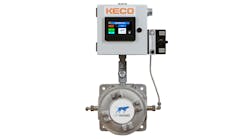The classic definition of main instrument vendor (MIV) is a contract placed with a single instrument specialist partner to provide a total solution for a project, including valves. Endress+Hauser has taken MIV and main valve vendor (MVV) to another level.
MIV is a concept founded on solid business principles of cost and risk reduction, scheduled savings and improvement on manual, cumbersome, traditional project methods. It’s about providing solutions to challenges our customers face, and in some instances are not even aware of, and providing the solutions and services that they didn’t know they needed. We have created an effective, measurable, concise and process-driven way for the valve and instrumentation scope that also aligns with compressed project schedules and time savings, reducing cost and risk to our customers.
We, as a company, have built on the MIV concept to differentiate and augment more value to all parties and stakeholders involved in a project. We've taken our years of experience of working on projects, and adapted the concept to meet our customers’ needs on an individual level. We're continuing to modify the concept to continuously improve the process and meet specific project needs. From feed to operation, our customers work with one partner to ensure consistency, leverage purchasing from multiple suppliers, realign when the project timeline shifts, avoid ambiguities, and provide a total solution for their project.
Some companies have similar offerings, but not all that offer MIV as a service can effectively expedite and execute all the aspects that are needed.
Top 10 reasons to consider MIV
- Customers would like to speed market access to their product. Successful implementation of an MIV project during construction can significantly reduce time-to-market for a new product.
- Customers want to mitigate risk during projects. The MIV takes on the risk associated with execution performance, documentation rework, lost freight, certain errors in ordering, and space utilization.
- MIV manages and executes to a compressed project schedule by prioritization across all suppliers, OEMs and contractors based on project priorities. When and as projects shift, the MIV must stay flexible and agile to accommodate the project changes. As schedules and plans change, being able to adapt in a timely manner without skipping a beat is expected, and is a must.
- The MIV is the single point of contact for every stakeholder involved in the process. It provides one vantage point to control, manage and report project progress. When the customer, EPC and other vendors have questions, they contact the MIV. Simplicity is key for the customer.
- Traditional methods include a slow, cumbersome, manual process with long lead times. The MIV improves efficiency and consolidates efforts, and decreases time invested by the customer’s procurement department by reducing total number of purchase orders, quotations, invoices and resources. The MIV reduces customer procurement staff requirements by transferring the procurement and quality tasks to itself.
- Managing documentation for each instrument and valve can be overwhelming. The MIV manages all documentation digitally and transmits it through one location as necessitated by the project. When it’s needed, it’s organized and in one place.
- Customers want to make sure they’re receiving their instrumentation and valves, and want to know at what price. The MIV consolidates reporting, analysis and auditing of pricing project-wide.
- Knowing the status of the project is critical for stakeholders. The MIV produces and distributes customized, consolidated project reporting to all stakeholders.
- The MIV receives, verifies and validates each tag and its documentation against selected, project-specific needs. It ensures consistent tagging of all items for the project, enabling confidence in traceability to engineering and design specifications.
- Customers want and expect quality work. The MIV maintains the ability to implement, adhere to, and follow rigorous project quality control standards.
- Reduced time to market
- Risk management
- Schedule management
- Communication and collaboration management
- Optimized supply chain
- Consistency of documentation
- Commercial (cost) management
- Status reporting
- Inspection/receipt verification/tagging
- Quality management
How Endress+Hauser manages an MIV
One critical area where our expertise adds value is we can execute and expedite more effectively because of our 60-plus years of manufacturing experience, and because we bring to the table a myriad of solutions to suppliers to help them shorten lead times. We add value to the process by working with our suppliers to help improve their lead times. We take necessary steps and actions to ensure items are in conformance before installation. If there is a nonconformance issue, it’s identified during our rigorous receipt verification, and we work to get it corrected before items are installed. Once everything is ordered and shipped, we do onsite services, startup and commissioning. Although the project seems complete, we don’t just walk away, we collaborate until the plant is up and running properly.
We've worked on MIV/MVV projects ranging from 500 to 40,000-plus tags and some key benefits mentioned by EPCs and customers can be summed up in three categories:
- Accelerated project ramp-up/mobilization
- Control of the project, effective execution during the project
- Ease of startup
If you think about everything EPCs and customers must prepare in order to execute and expedite a project, most of the time, resources, project timeline and budget become challenges that hold up project progress. Having an MIV partner accelerates project ramp-up time. Depending on the size of a project, what can sometimes take a company six months to align and prepare, would take us just a few weeks. EPCs and customers aren’t only getting an MIV, they’re receiving all the resources that come with it—the people support, technical and engineering support, knowledge of processes, tools, facility space for executing and expediting.
Think about some of the projects you’ve worked on. What challenges and shifts occurred during the project? How did those affect the project’s timeline, budget and people? Were the challenges handled in an efficient manner? How many stakeholders did you have? Was it easy communicating back and forth between the stakeholders and the other parties to the project? The MIV’s responsibility is to manage prioritization of the project. When the project shifts, the EPC and customer communicate to the MIV, and the MIV takes care of the rest, including expediting and reporting. The MIV reports back to the EPC and customer. One single point of contact facilitating and managing the communication of the project reduces complexity of the entire project.
Simplifying startup for the customer is key. Before any instrument is installed, we check it for conformance. We make sure our customer has all necessary documentation, including drawings, for each instrument and valve. We align schedules and provide pre-commissioning and startup support. This ensures instruments and valves are working properly, and our customers’ process is and will run efficiently.
After being part of projects with inefficiencies, we knew there had to be a better way to execute a project, and we made it our mission to improve the process. Working with our customers and EPCs on projects has enabled us to come up with new ways to meet, achieve and surpass our customers’ expectations. In the end, our customer successes are our successes, and we enjoy partnering with our customers to tackle challenges, streamline their processes and exceed goals.
Click here for more information or watch the video.

Leaders relevant to this article:





